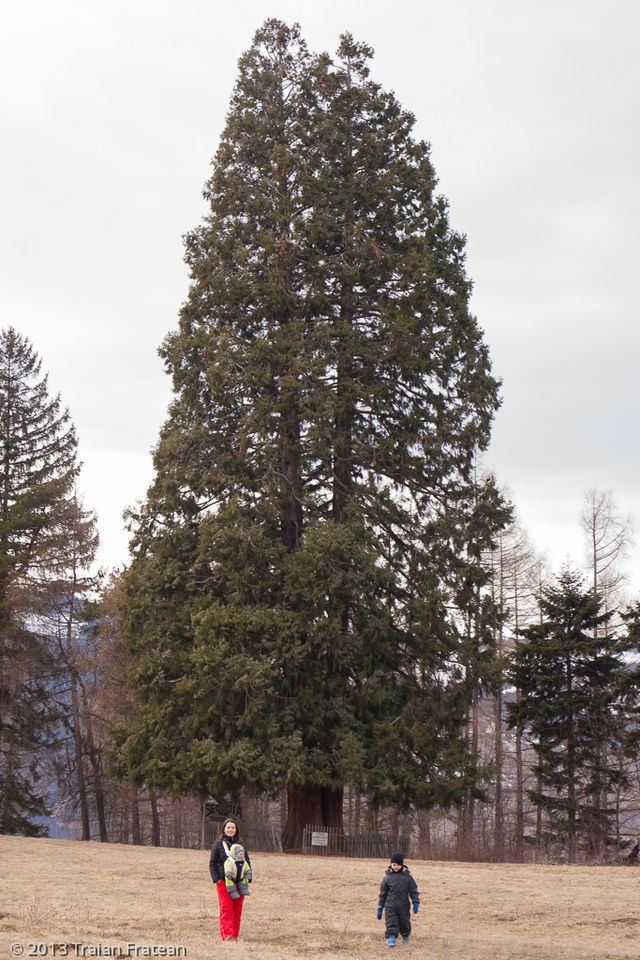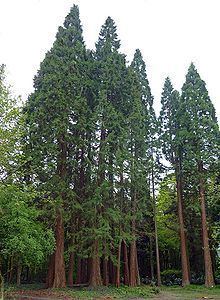Higher classification Cypress | Division Pinophyta Scientific name Sequoioideae Rank Subfamily | |
 | ||
Lower classifications Coast redwood, Giant sequoia, Metasequoia glyptostroboides | ||
Sequoioideae (redwoods) is subfamily of coniferous trees within the family Cupressaceae. It is most common in the coastal forests of Northern California.
Contents
- Description
- Record holders
- Taxonomy and evolution
- Evidence for reticulate evolution in Sequoioideae
- California USA
- China
- Paleontology
- Conservation
- Introduced range
- Cultural impact
- References

Description
The three redwood subfamily genera are Sequoia and Sequoiadendron of California and Oregon, United States; and Metasequoia in China. The redwood species contains the largest and tallest trees in the world. These trees can live thousands of years. This is an endangered subfamily due to habitat losses from fire ecology suppression, logging, and air pollution.
Only two of the genera, Sequoia and Sequoiadendron, are known for massive trees. Metasequoia, with the living species Metasequoia glyptostroboides, are much smaller.
Record holders
Taxonomy and evolution
Multiple studies of both morphological and molecular characters have strongly supported the assertion that the Sequoioideae are monophyletic.
Most modern phylogenies place Sequoia as sister to Sequoiadendron and Metasequoia as the out-group. However, Yang et al. went on to investigate the origin of a peculiar genetic artifact of the Sequoioideae—the polyploidy of Sequoia—and generated a notable exception that calls into question the specifics of this relative consensus.
Evidence for reticulate evolution in Sequoioideae
Polyploidy has come to be understood as quite common in plants—with estimates ranging from 47% to 100% of flowering plants and extant ferns having derived from ancient polyploidy. Within the gymnosperms however it is quite rare. Sequoia sempervirens is hexaploid (2n= 6x= 66). To investigate the origins of this polyploidy Yang et al. used two single copy nuclear genes, LFY and NLY, to generate phylogenetic trees. Other researchers have had success with these genes in similar studies on different taxa.
Several hypotheses have been proposed to explain the origin of Sequoia's polyploidy: allopolyploidy by hybridization between Metasequoia and some probably extinct taxodiaceous plant; Metasequoia and Sequoiadendron, or ancestors of the two genera, as the parental species of Sequoia; and autohexaploidy, autoallohexaploidy, or segmental allohexaploidy.
Yang et al. found that Sequoia was clustered with Metasequoia in the tree generated using the LFY gene, but with Sequoiadendron in the tree generated with the NLY gene. Further analysis strongly supported the hypothesis that Sequoia was the result of a hybridization event involving Metasequoia and Sequoiadendron. Thus, Yang et al. hypothesize that the inconsistent relationships among Metasequoia, Sequoia, and Sequoiadendron could be a sign of reticulate evolution (in which two species hybridize and give rise to a third) among the three genera. However, the long evolutionary history of the three genera (the earliest fossil remains being from the Jurassic) make resolving the specifics of when and how Sequoia originated once and for all a difficult matter—especially since it in part depends on an incomplete fossil record.
California, USA
China
Paleontology
Sequoioideae is an ancient taxon. The first Sequoioideae, Sequoia jeholensis, was discovered in Jurassic deposits. The fossil record shows a massive expansion of range in the Cretaceous and dominance of the Arcto-Tertiary flora, especially in northern latitudes. Genera of Sequoioideae were found in the Arctic Circle, Europe, North America, and throughout Asia and Japan. A general cooling trend beginning in the late Eocene and Oligocene reduced the northern ranges of the Sequoioideae, as did subsequent ice ages. Evolutionary adaptations to ancient environments persist in all three species despite changing climate, distribution, and associated flora. Especially the specific demands of their reproduction ecology ultimately forced each of the species into refugial ranges where they could survive, but still only in a vulnerable state.
Conservation
The entire subfamily is endangered. The IUCN Red List Category & Criteria assesses Sequoia Sempervirens as Endangered (A2acd), Sequoiadendron giganteum as Endangered (B2ab) and Metasequoia glyptostroboides as Endangered (B1ab).
Introduced range
The two California redwood species, since the early 19th century, and the Chinese redwood species since 1948, have been cultivated horticulturally far beyond their native habitats. They are found in botanical gardens, public parks, and private landscapes in many similar climates worldwide. Plantings outside their native ranges particularly are found in California, the coastal Northwestern and Eastern United States, areas of China, Germany, the United Kingdom, Australia and near Rotorua New Zealand. They are also used in educational projects recreating the look of the megaflora of the Pleistocene landscape.
Cultural impact
John Steinbeck wrote about the redwood, "The redwoods, once seen, leave a mark or create a vision that stays with you always. No one has ever successfully painted or photographed a redwood tree. The feeling they produce is not transferable. From them comes silence and awe. It's not only their unbelievable stature, nor the color which seems to shift and vary under your eyes, no, they are not like any trees we know, they are ambassadors from another time."
